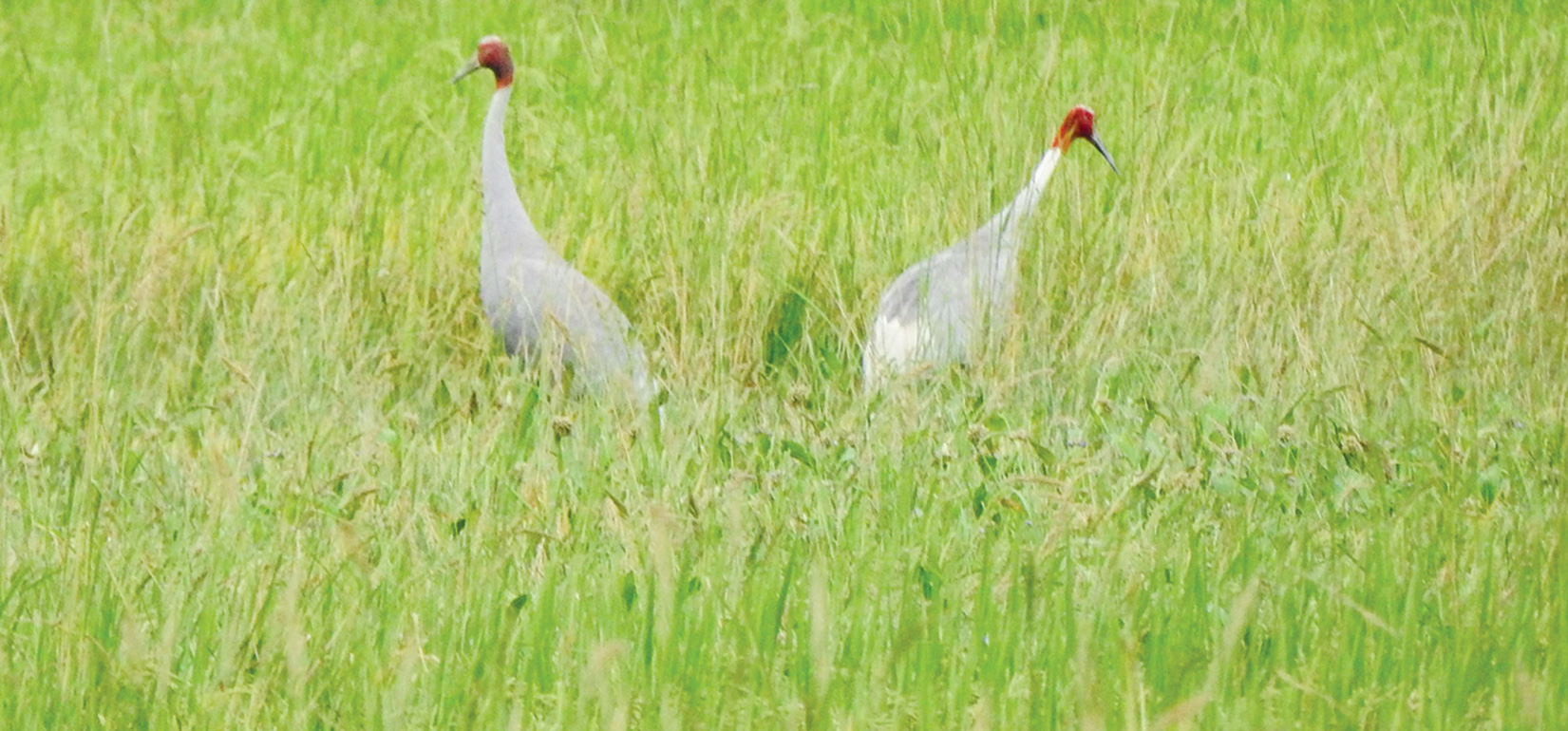Sarus crane reappears in Kailali’s Puraina Lake after a decade

By Abinash Chaudhary
Dhangadhi, Sept. 13: Rare species of bird ‘Sarus crane’ (Antigone antigone) has reappeared after 12 years at Puraina Lake area of Bhajani Municipality-7 of Kailali district.
The species, which suddenly disappeared after the destruction of its habitat, has reappeared in the area this year. A pair of Sarus crane has been living in the area for a few days, locals said.
The lake connecting Basanta Biological Marg and Dudhuwa National Park was known as a Sarus crane habitat in the past. However, the birds disappeared after the Mohana River flooded the lake in 2009. There is no sign of the lake now as human intervention has increased after it was damaged by the river floods.
According to ornithologist Hirulal Dangaura, the Sarus cranes were sighted at the lake area this year after the water body of the past has been turned into arable land. “There is water and paddy in the lake area,” he said. A pair of Sarus crane is seen in the paddy field,” he said.
Conservationists are excited after the return of a pair of crane to its old habitat. “It is nice to see the birds return to their old habitat after a decade,” he said. He said that Sarus cranes are reappearing in Kailali as the condition of conservation is improving.
Two years ago, three Sarus cranes had reappeared in Mantriphanta of Bhajani Municipality. Similarly, they were seen in Puraini Lake in Belauri Municipality of Kanchanpur last year and in Chavanni, Kalikich area of Beldandi Municipality.
The Sarus crane has been listed as one of the rare birds in the world by the International Union for Conservation of Nature (IUCN).
According to the National Parks and Wildlife Conservation Act 2029, Sarus crane is considered a protected bird in Nepal. There is a legal penalty of Rs. 500 to Rs. 100,000 or imprisonment for three months to two years or both for hunting the bird or destroying their eggs.
The bird, once seen in large numbers in the Terai region, is now confined to Rupandehi and Kapilvastu districts. According to the Bird Conservation Nepal (BCN), now there are about 400 to 750 Sarus cranes in Nepal.
Of the 15 species of Sarus crane found around the world, four species are found in Nepal. They are blackhead, Laxman, Karyang-Kurung and Storks.
The Sarus crane is the highest flying bird in the world. About five feet tall, this bird weighs up to 10 kg. They lay eggs and hatch in open wetlands, irrigated paddy fields, ponds and lakes.
These birds are said to control the population of snakes and to help in grain production by eating insects as well as other small creatures that are harmful to crops.
Similarly, the species of bird are believed to help people to avoid being attacked by predators, such as tigers and leopards because they make alert calls when these animals are around.
Recent News

Do not make expressions casting dout on election: EC
14 Apr, 2022
CM Bhatta says may New Year 2079 BS inspire positive thinking
14 Apr, 2022
Three new cases, 44 recoveries in 24 hours
14 Apr, 2022
689 climbers of 84 teams so far acquire permits for climbing various peaks this spring season
14 Apr, 2022
How the rising cost of living crisis is impacting Nepal
14 Apr, 2022
US military confirms an interstellar meteor collided with Earth
14 Apr, 2022
Valneva Covid vaccine approved for use in UK
14 Apr, 2022
Chair Prachanda highlights need of unity among Maoist, Communist forces
14 Apr, 2022
Ranbir Kapoor and Alia Bhatt: Bollywood toasts star couple on wedding
14 Apr, 2022
President Bhandari confers decorations (Photo Feature)
14 Apr, 2022










